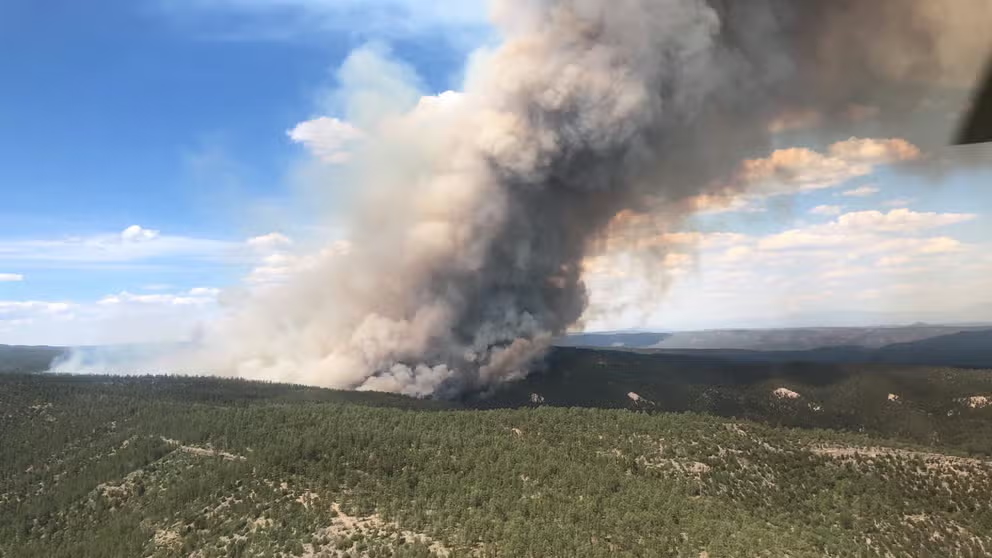'Bogus' Fire? 'Dinosaur' Fire? 'Airline Fire'? Here's how wildfires get their names
Typically, wildfires are given a name that references a nearby landmark or geographic moniker that would make clear where the fire started and where it's burning.
How do they name wildfires?
Unlike hurricanes, wildfires are named on the spot from local fire agencies, but there are some do's and don'ts when it comes to choosing a name.
Those in the West following the wildfire season this summer might be scratching their heads over some of the names scattered across the headlines:
"Bogus" Fire? "Airline Fire"? "Dinosaur Fire"?
The first one was very real; the latter two didn't involve airplanes or raptors. Instead, they were just descriptive titles for the fires. But how do wildfires get their (sometimes unusual) names?
WHAT YOU SHOULD KEEP IN YOUR EVACUATION ‘GO’ BAG DURING WILDFIRE SEASON
Unlike hurricanes and tropical storms, whose storm names are determined by a central authority -- in their case, the World Meteorological Organization -- naming wildfires is left up to the fire unit, incident commander, or dispatch center in the jurisdiction where the fire began.
HOW TO BEST PREPARE YOUR HOMES FOR WILDFIRES
Typically, wildfires are given a name that references a nearby landmark or geographic moniker that will make clear where the fire started and where it's burning. So, if multiple fires are burning in a region, you'll have a better idea of which fire is which based on location.
For example, the Bogus Fire in northern California started burning along Little Bogus Creek Road. The Airline Fire was burning not too far from central California's Airline Highway. The Dinosaur Fire burning just west of Boulder, Colorado is in an area known for dinosaur fossil discoveries. Other rather creative fire names this season include the Pay Fire, French Fire, and Grande Fire.
In the wildfire season of 2022, the Sheep Fire was burning near Sheep Creek Road in California's San Bernardino County. The Bird Fire was located near Bird Spring in New Mexico. The Haywire Fire was named for New Mexico's Haywire Crater.

HOW TO BEST PREPARE YOUR HOMES FOR WILDFIRES
The National Interagency Fire Center has some additional guidelines for naming fires:
- The fire name needs to be relatively unique. If two separate fires are burning near the same geographic features, append a number at the end such as Silver 1 and Silver 2.
- Don't use a name for a new fire that is already currently in use somewhere else in the nation.
- Don't add in generic feature descriptions such as "peak" or "creek" or street names. For example, if the fire is along Magnolia Drive, call it the Magnolia Fire. A fire along Pebble Creek would become the Pebble Fire. This is how we ended up with "Bogus Fire" and not "Bogus Creek Fire"
- Don't use names that are "potentially prophetic, hyperbolical, or distastefully descriptive such as 'Deadman' or 'Firestorm.'"
- Much like how names from destructive hurricanes are retired the next year, avoid using a name that was already used in a historic or catastrophic fire.
- Don't name it after a person "aside from a historical person's name used for a location or feature that is otherwise suitable for the fire name."
- Don't use slang, a double entendre or wordplay, or anything that might be found offensive or insensitive.
- Don't use names from private property or commercial business or protected by trademark. That means no "McDonalds" Fire or "Home Depot" Fire, for example.
- Don't name the fire after a potential ignition source, even if the source is known, such as "BNSF fire" or "Youth Group BBQ Fire". Also, don't name after an ignition source that implies liability such as Powerline Fire or Pipeline Fire. (Yes, that would seem to contradict the "Pipeline Fire" that burned in Arizona in 2022, but that fire got its name from the nearby underground natural gas pipeline that runs between Flagstaff and the San Francisco Peaks, according to Coconino National Forest officials. The cause of the fire is still shown as "undetermined".)
- Finally: If any doubt, assign the fire another name.
Not all wildfires are named for their location
While geography plays a large part in a vast majority of wildfire names, sometimes firefighters will bestow a name that isn't a geographical reference.
MEET THE METEOROLOGISTS WHO HEAD TOWARD THE HEART OF A FIRE
The Midnight Fire for example, was also burning in New Mexico in 2022. But it indeed got its name from the time of day, not a nearby creek or ridge or street.
"The Midnight Fire earned its name from the several-hour hike that it took to locate it after it was reported," fire officials told FOX Weather. "Crews didn't arrive on scene until midnight due to the remote and rugged terrain in the backcountry."
